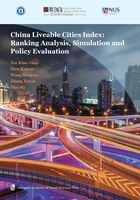
1.1 Urbanisation in China and Its Challenges
Over the past few decades, urbanisation has been the major driver of economic growth for countries all over the world. As predicted by the 2018 World Urbanisation Prospects (United Nations), the urban population will increase from 55% in 2018 to 68% in 2050, which is equivalent to 2.5 billion in number. About 90% of this increment will be from Asia and Africa.China, in particular, will contribute 255 million urbanites by 2050.
The rapid urbanisation has overwhelmed the city's infrastructure and led to a shortage of public services, such as housing, education and healthcare. Housing shortage arose more severely in major cities that have developed to their highs, as compared with the other ones in China. As illustrated in Figure 1.1, over the period from 2000 to 2018, the average growth rates of residential property price in Beijing and Shanghai, with close to 90% of people dwelling in urban areas, are about five percentage points higher than those in Guizhou and Yunnan, where less than 50% of people are urban residents.

Figure 1.1 Average Urban Population Ratios and Growth of Residential Property Prices in Selected Cities
Source:ACI and SASS Based on Data Retrieved from National Bureau of Statistics of China.
Although it comes as no surprise that people tend to move into those more developed areas, such a persistent trend in China might invoke some concerns. For example, housing shortage, which could be amplified by China's urban residency restriction, may further deteriorate China's inter-regional mobility and thus lead to greater regional inequality in China. To mitigate the problem, both central and local governments have introduced cooling measures to lower, if not maintain, the housing prices. In May 2010, Beijing first started the Home-Purchase Restriction Order. It is subsequently implemented in most of the cities in China. The restriction order prohibits households with local hukou from purchasing more than two houses and the households without local hukou from buying more than one house. In 2016, President Xi Jinping further emphasised that houses are built to be inhabited, not for speculation.
Pollution caused by automobiles is also a significant challenge under urbanisation. China has climbed up to be the fourth largest automobile producers of the world only a decade after its Eighth Five-Year Plan (1991—1995) designated the automotive industry as a pillar industry of the economy;the number of private automobiles registered increased from 14.53 million in 1999 to 232.31 million in 2018. On the other hand, the unneglectable cost of development is the emission of hazardous chemicals. As shown in Figure 1.2, the annual average concentration of airborne particulate matters (e.g. PM10 is particulate matters 10 micrometres or less) in Beijing, Shanghai, Guangzhou and Shenzhen was more than double the amount that the other selected developed cities reported from 2013 to 2016. While air pollution control and prevention plan announced by the State Council in 2013 and the new Environmental Protection Law passed in 2015 could account for the decreasing trends of particle concentration in these cities, it is still a long way to catch up with the air quality in other developed cities.

Figure 1.2 Annual Average Concentration of Airborne Particles in Selected Cities
Source:ACI and SASS Based on Data Retrieved from WHO Global Ambient Air Quality Database.
Traffic congestion is another a severe problem caused by automobiles in China's major cities, particularly in the conventional first-tier ones (Beijing, Shanghai, Guangzhou, and Shenzhen). As estimated by the World Bank, Beijing's average peak-hour vehicle speeds on main roads between its Second and Third Ring Roads were on a continuous declining trend, from as high as 45 km per hour in 1994 to as low as 10 in 2005;no better than Beijing, Shanghai also sees cars run on an average rate of 9 km to 18 km per hour during peak hours (Liu and Smith 2006). A lack of prompt control certainly seeded China's vehicle boom, as the earliest policy control for such a surge was Beijing's license plate lottery system announced in 2010, when another country Singapore's COE policy (also for controlling the number of household vehicle ownerships) had already been implementing for 20 years. However, even with the policy control, major cities in China still have to bear all the irreversible establishment because vehicle plates granted almost never expire and the large vehicle base in those cities will thus persist; existing controls only curb the momentum of increase in automobiles but not the sheer size thereof.
How to change people's mindset to choose public transport over private cars is also crucial in solving the traffic problem. As of 2017, only 33% of residence in Shanghai choose public transport. The figure is 44% in Singapore and 88% in Hong Kong. Chapter 5 of this book will further study the concept of liveability in terms of transportation, presenting a comparative analysis on New York, London, Tokyo, Singapore, Hong Kong and Shanghai.
Good soft and hard infrastructure alone could not guarantee high liveability of a city. The riots in Hong Kong since 9thJune 2019 demonstrates the important role of city governance and public security in determining the city's liveability. According to telephone-survey conducted by Asia Competitiveness Institute (ACI) and Shanghai Academy of Social Sciences (SASS), the general public in Hong Kong gives a lower score in both government services and its efficiency compared to the other 99 Chinese cities.
The rest of this chapter will discuss the concept of liveability and present the ACI—SASS liveability framework. The outline of this book will be presented in section 1.4.